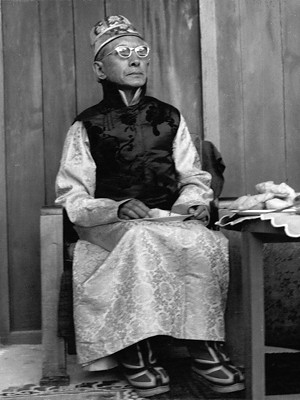National Anthem of Sikkim

After the passing of Chogyal Tashi Namgyal in 1963 and Pandit Jawaharlal Nehru in 1964, the mutual agreements of these statesmen faced increasing disregard. Counteracting a clearly sensed rise of external threats to the very existence of the Buddhist Kingdom of Sikkim, formal attributes of national sovereignty were attached major relevance. Members of the country's elite undertook late but dedicated efforts to affirm the distinct identity of Sikkim to the outside world as well as to themselves.
With regard to the National Anthem Denjong Silé Yang Chagpa Chilo, Basnet reports that
"... Indian eyebrows were raised when Sikkim started playing its 'National Anthem'. The annual presentation of Colours to the Sikkim Guards by the Chogyal was looked upon with suspicion and disfavour by the Political Officer when it was announced that the National Anthem of Sikkim would be played on that occasion. The Political Officer boycotted the function in 1965 and advised other Indians against attending the ceremony. The ceremony went off admirably, the Political Officer's discomfiture lending zest to the Sikkimese participants." 1
The Chogyal possibly had Indian objections in mind when he wrote down the following comment carrying - between the lines - the message that presentation of the Anthem wasn't a novelty but a privilege reserved for the highest ranks and, thus, may have escaped the notice of subordinate Indian officials:
"The National Anthem of Sikkim is over 300 years old and has always been sung on appropriate occasions and in recent years played by Sikkimese Military Bands. The Sikkim National Anthem was played with the Indian National Anthem in honour of the Prime Minister of India when the Honour Guards was presented by the Sikkim Guards. Protocol demands that the Anthem be played only when a Royal or National Salute is given to which only Heads of States are entitled to and as a special mark of courtesy may be extended to Prime Ministers in certain cases. Hence the Sikkim National Anthem may not have been heard when other VIPs from India have arrived in Sikkim as they would receive only the general Salute." 2
Several years later, the Anthem was recorded in musical notation by Nari K. Rustomji, Dewan of Sikkim from 1954 to 1959. Rustomji refers to the Chogyal's request made in late 1972:
"One of the Prince's concerns at the time was the setting to music of Sikkim's National Anthem and he wanted me to undertake the task. I informed him that, although I was a moderately competent musician, I had no experience of orchestration, which required considerable technical know-how. He nevertheless insisted that, forgetting about orchestration, I should at least make an attempt at translating the tune to musical notation so that the band of the Royal Guard, designated as the Sikkim Guard, could perform it at the ensuing Birthday celebrations. His feeling was that my technical inexpertise would be more than compounded by the consideration that I would have a surer instinct in interpreting the spirit of a Sikkimese tune than any other outsider and that, in any case, he would, for reasons of sentiment, wish me, his closest friend, to be thus associated with his country's national anthem. It was not an easy task, as every person summoned to assist and sing the tune for me presented some slight variations and I was bewildered as to what I should finally settle upon as the authorised version. The Prince himself conducted the Guards band during our rehearsals to ensure the correctness of the tempo and other niceties and between the two of us, amateurs though we were, we did not do too badly, though Beethoven and Toscanini might not have entirely approved!" 3
The tune was played by the Palace Guard's Band on the occasion of royal receptions and national celebrations. It was last sung by the Palace Guards when they were detained by Indian troops, in 1975, and spontaneously resurfaced during the funeral rites for the 12th Chogyal and the subsequent nomination of the 13th Chogyal, in 1982.4 Thereafter, Denjong Silé Yang Chagpa Chilo disappeared into oblivion, so much so that later generations were led to believe a Nepali song to be the National Anthem of Sikkim.
The confusion rose due to the label 'National Song of Sikkim' tagged to Jahan Bagcha Teesta Rangeet by a noted historian of Sikkim. The composition by Nepali artists Sanu Lama (Lyrics) and Dushyant Lama (Music) was presented to Chogyal Palden Thondup Namgyal on the occasion of the coronation anniversary celebrations on April 4, 1970. The song was to become very popular across all sections of the Sikkimese population down to the present day. Though this is not the National Anthem of Sikkim, the song may, thus, be termed the 'Heart Anthem of the Sikkimese'.
Full text of the National Anthem of Sikkim in Denjongké (Sikkimese):

1 Lal Bahadur Basnet, Sikkim: A Short Political History, New Delhi, 1974, p.125
2 Document preserved at the Sikkimese Palace Archive NIT, contributed by Tenzin C. Tashi
3 Nari Rustomji, Sikkim: A Himalayan Tragedy, Ahmedabad, 1987, p. 90
4 Sikkim: The Sounds of Silence, India Today, March 15, 1982
PDF-Document: National Anthem of the Kingdom of Sikkim in Denjongké, English and Wylie-Transliteration.
Photo Credit: Rogers Photo Archive, Keystone Media
